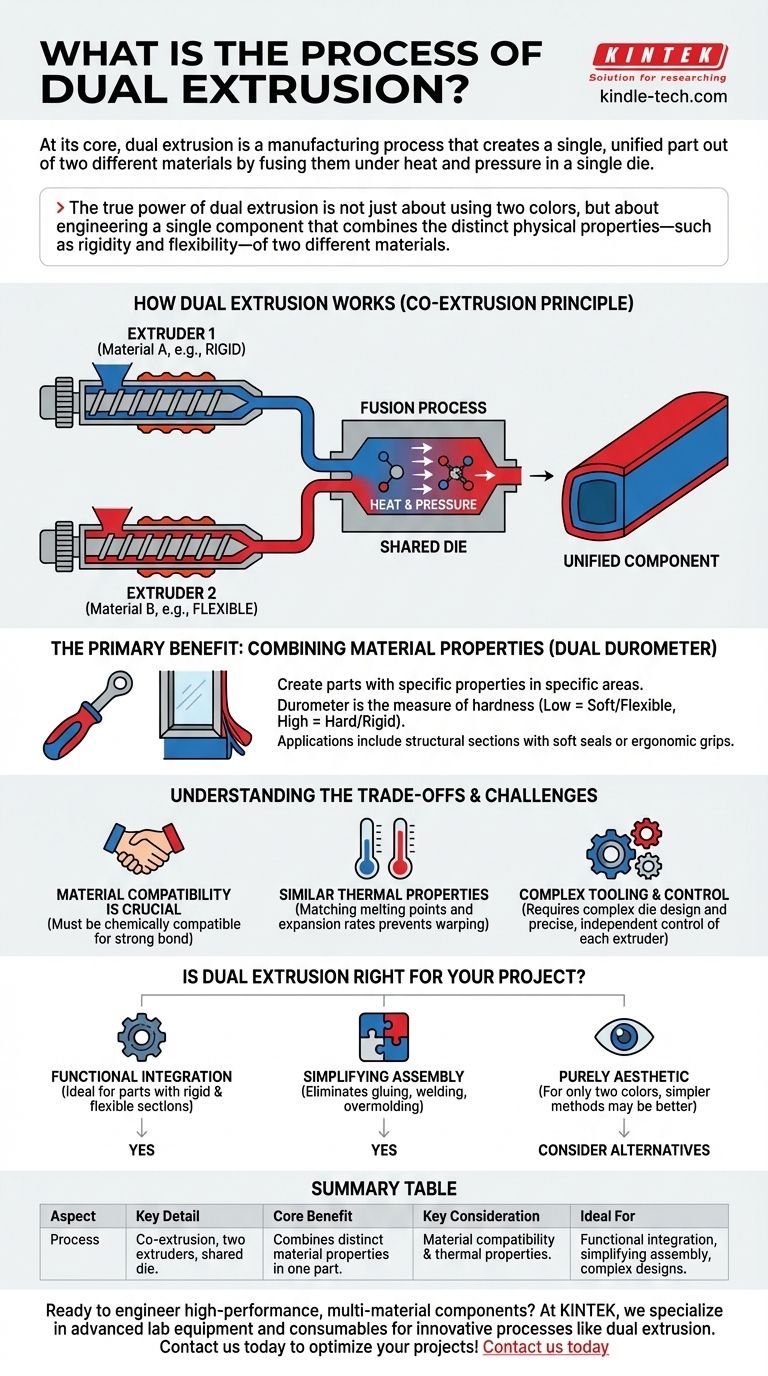At its core, dual extrusion is a manufacturing process that creates a single, unified part out of two different materials. It achieves this by feeding two distinct materials through separate extruders into a single die at the same time, where they are fused together under heat and pressure.
The true power of dual extrusion is not just about using two colors, but about engineering a single component that combines the distinct physical properties—such as rigidity and flexibility—of two different materials.

How Dual Extrusion Works
Dual extrusion is a sophisticated form of a broader process known as co-extrusion. Understanding the mechanics reveals why it is so effective for creating complex parts.
The Principle of Co-extrusion
The process involves two or more extruders, each dedicated to a specific material. These machines heat and push their respective materials forward.
The Shared Die
The critical element is the shared die. Molten materials from both extruders are forced into this single, specially designed tool simultaneously.
The Fusion Process
Inside the die, the materials merge under precise heat and pressure. This forms a molecular bond between them, creating a single, continuous profile rather than two separate pieces that are simply joined together.
The Primary Benefit: Combining Material Properties
The most significant advantage of this process is the ability to create parts with specific properties in specific areas. This is often referenced as dual durometer extrusion.
Understanding "Durometer"
Durometer is the standard measure of a material's hardness. A low durometer indicates a soft, flexible material, while a high durometer signifies a hard, rigid one.
Practical Applications
This allows for the creation of a part with both a rigid structural section and a soft, flexible sealing or gripping section. Think of a window seal with a hard base to clip into a frame and a soft flap to block air, or a tool handle with a rigid core and a soft, ergonomic grip.
Understanding the Trade-offs and Challenges
While powerful, dual extrusion is a complex process with specific requirements that must be carefully managed for success.
Material Compatibility is Crucial
The two materials must be chemically compatible to ensure a strong, permanent bond. If they are not, the part can delaminate or fail at the seam.
Similar Thermal Properties
Materials must also have similar melting temperatures and rates of thermal expansion. Mismatched properties can cause the part to warp or distort as it cools.
Complex Tooling and Control
The design of a co-extrusion die is significantly more complex and costly than a single-material die. The process also requires precise, independent control over the temperature and pressure of each extruder.
Is Dual Extrusion Right for Your Project?
To determine if this process is the correct choice, consider the fundamental goal of your component.
- If your primary focus is functional integration: Dual extrusion is ideal for creating a single part with both rigid and flexible sections, such as a combination seal and mounting clip.
- If your primary focus is simplifying assembly: This process can eliminate the need for secondary steps like gluing, welding, or overmolding two separate components, reducing labor and potential points of failure.
- If your primary focus is purely aesthetic: For parts that only require two colors without different physical properties, simpler and more cost-effective manufacturing methods may be a better fit.
Ultimately, dual extrusion empowers engineers to create highly integrated, single-piece solutions for complex design challenges.
Summary Table:
| Aspect | Key Detail |
|---|---|
| Process | Co-extrusion using two extruders and a shared die. |
| Core Benefit | Combines distinct material properties (e.g., rigid & flexible) in one part. |
| Key Consideration | Material compatibility and similar thermal properties are critical. |
| Ideal For | Functional integration, simplifying assembly, and complex component design. |
Ready to engineer high-performance, multi-material components?
At KINTEK, we specialize in providing advanced lab equipment and consumables that support innovative manufacturing processes like dual extrusion. Whether you're in R&D or production, our solutions help you achieve precise material testing and processing for superior results.
Contact us today to discuss how KINTEK can support your laboratory needs and help you optimize your dual extrusion projects!
Visual Guide

Related Products
- CVD Diamond Domes for Industrial and Scientific Applications
- Professional Cutting Tools for Carbon Paper Cloth Diaphragm Copper Aluminum Foil and More
- High Shear Homogenizer for Pharmaceutical and Cosmetic Applications
- Custom CVD Diamond Coating for Lab Applications
- Lab Internal Rubber Mixer Rubber Kneader Machine for Mixing and Kneading
People Also Ask
- How is something diamond coated? A Guide to CVD Growth vs. Plating Methods
- How thick is diamond coating? Achieve Unprecedented Precision with Ultra-Thin Films
- Do CVD diamonds have resale value? The Truth About Lab-Grown Diamond Investment
- What is the application of diamond coating? Solve Complex Wear, Heat, and Corrosion Problems
- What is the difference between CVD diamond and natural diamond? A Guide to Making an Informed Choice





